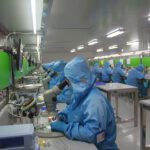Is There an Insourcing Movement Afoot?
Today, China is dominant in high-volume, low-mix manufacturing, yet there is a groundswell of activity to return manufacturing to North America and Europe. John MacWilliams asks: Is there an insourcing movement afoot?
 The contract manufacturing movement started in the late ’80s. This outsourcing movement freed up OEM resources so they could concentrate on product design and marketing, and it removed direct labor and manufacturing investments. As China emerged as THE location for contract manufacturers, many companies were dedicated to one or two OEMs’ production or product specialties. It is said that Terry Gou, chairman of Foxconn, got his start in contract manufacturing by taking CEOs of computer OEMs to see their new factories in China even before they’d made any plans to relocate. Foxconn grew from a <$1B connector company in 1990 to more than $100 billion in EMS revenues by 2014.
The contract manufacturing movement started in the late ’80s. This outsourcing movement freed up OEM resources so they could concentrate on product design and marketing, and it removed direct labor and manufacturing investments. As China emerged as THE location for contract manufacturers, many companies were dedicated to one or two OEMs’ production or product specialties. It is said that Terry Gou, chairman of Foxconn, got his start in contract manufacturing by taking CEOs of computer OEMs to see their new factories in China even before they’d made any plans to relocate. Foxconn grew from a <$1B connector company in 1990 to more than $100 billion in EMS revenues by 2014.
This growth led to a new discipline – logistics management. Over time it hollowed out the US high-volume/low-cost manufacturing infrastructure, caused a loss of manufacturing engineering talent, and moved some design engineering to Asian outsourced locations.
Today, China is dominant in high-volume, low-mix manufacturing, mostly with manual bench assembly, but there is a groundswell of activity that indicates a desire to return manufacturing – or start new manufacturing projects – in North America, and most likely in Europe as well. Recent articles in The Wall Street Journal describe domestic manufacturers who typically outsource product assembly now looking for domestic firms to engage in new consumer electronic projects. What these companies found, however, was that domestic firms couldn’t or wouldn’t compete unless unacceptable terms were met, particularly if volume did not run into the hundreds of thousands. This embryonic insourcing movement continues, however, as many company executives (including some at Apple) experienced negative publicity and indirect costs associated with large off-shoring activities. They are dipping their toes in the insourcing waters.
So, where are we? And what are the advantages and disadvantages to each side?
Reasons to Insource to the United States/Europe:
- Tighter quality control
- Shorter supply lines
- Protection of intellectual property and engineering resources
- Lower shipping costs
- No language and time zone issues
- Increased flexibility for product design changes
- Availability of new manufacturing technologies like robotics
- Lower energy costs
- Public relations benefits
- Helps rebuild domestic infrastructure
- Helps improve US/European manufacturing employment trends
- Helps lower trade deficit
- No socio/political risks like those in China
- Logistics, shipping costs, and time-to-market are simplified
- Labor costs are rising in China
Reasons to Outsource to China
- Much lower (but rising) direct labor costs
- Much lower indirect costs (administrative, engineering, RD&E)
- Large, well established EMS firms
- Significantly improved infrastructure
- Rapid movement toward automation
- Most manufacturing equipment suppliers are now in China
- University training and research is accelerating
- Hundreds of EMS suppliers, many that specialize in particular product areas
- Component companies’ OEM/EMS customers are in China and want suppliers there
- China’s EMS firms seem to be more flexible
- China’s EMS firms want the business
- Avoid higher corporate taxes
- No need to repatriate “parked” foreign earnings
- Avoid EPA and other regulations
- Embedded infrastructure is already in China
Domestic connector companies follow their customers to wherever they manufacture. When and if large blocks of insourcing do occur, connector suppliers will return manufacturing operations to the United States and Europe, if it makes economic sense. But even that is complicated by the connector industry’s global supply chain. Insourcing of connector manufacturing will require automation to reduce direct labor costs.
- Electric Vehicles Move into the Mainstream with New EV Battery Technologies - September 7, 2021
- The Dynamic Server Market Reflects Ongoing Innovation in Computing - June 1, 2021
- The Electronics Industry Starts to Ease Out of China - November 3, 2020







